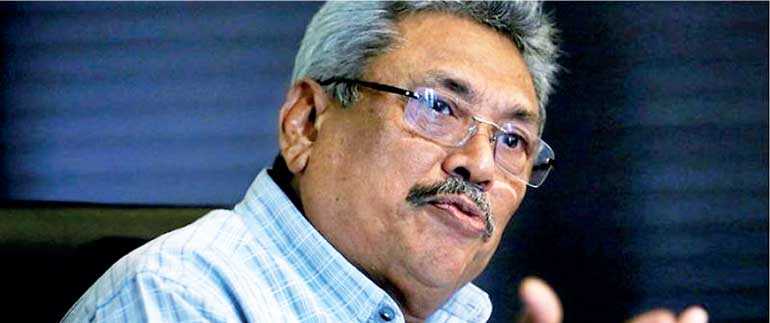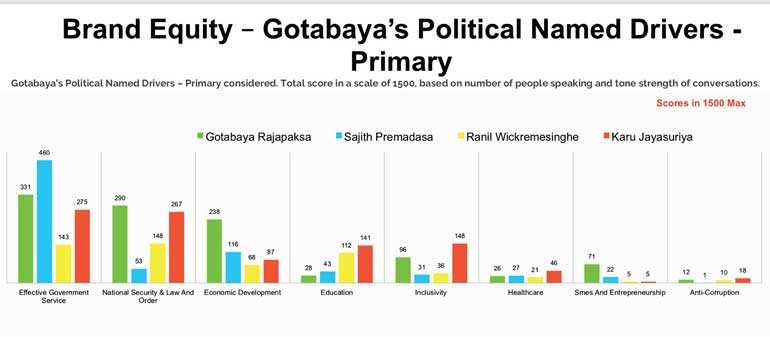Thursday Nov 20, 2025
Thursday Nov 20, 2025
Tuesday, 17 September 2019 00:00 - - {{hitsCtrl.values.hits}}

Brand Gotabaya’s key driver: Effective Government service
In the backdrop of the $ 93 billion economy, Sri Lanka is wobbling with overall household consumption declining to 4.7% growth and GDP forecasted at 2.7%, which means Sri Lanka is in for tough times. In this backdrop the first candidate off the block to the presidential candidacy was brand Gotabaya. Last week he announced to Sri Lanka ‘the promise’ to the nation, which was interesting.
A point to note is that brand Gotabaya’s promise comes in the regional background of South Asia’s GDP growing at 5% which explains the ‘as is status’ of Sri Lanka in relation to our neighbouring countries – India, Pakistan and Bangladesh and the opposition being in disarray. This is the worry for corporate Sri Lanka which is just recovering from the Easter attacks and some businesses crashing by almost 60%. 
For instance the quarterly results of publicly quoted companies announced that JKH leisure business had made a loss of Rs. 224 million at a -30% vs LY, the Aitken Spence hotels sector had recorded a loss of Rs. 385 million at a -47% and the Hemas leisure business a Rs. 160 million loss at a -30% vs LY just to name the top companies of Sri Lanka.
Gotabaya’s drivers
If we look at the key drivers of brand Gotabaya and under the diagnostic of Artificial Intelligence (AI) perception diagnostics the key attribute emerging is “Efficient Government Service, followed by National Security, Law and Order, thereafter Economic Development, followed by Education, Inclusivity and Healthcare – the last two being SMEs/Entrepreneurship and Anti-Corruption,” as per the foremost AI perception management company Clootrack.
AI deep dive – Gotabaya leading
The report does a deep dive to each of the attributes that Gotabaya has declared which is called in marketing jargon ‘named brand drivers’. On this front brand Gotabaya is leading on the key equity drivers announced by the said candidate.
On the key driver ‘Effective Government Service,’ brand Sajith is ahead marginally ahead of Brand Gotabaya, whilst the latter is a clear leader as against brand Sajith in the second attribute ‘National Security, Law and Order’. The reason for the strong equity of brand Karu is because of his performance last October in Parliament during the siege by both parties. This is the power of AI-based analysis.
On the third attribute of ‘Economic Development,’ brand Gotabaya comes out strongly but weak on ‘Education,’ which may be because of the non-traction on this area in his work today.
Gotabaya equity strong – wave 1
If we call this wave 1 – August 2019, we can say that brand Gotabaya is strong in the DNA of a would-be voter. However, a lot of work needs to be done as we need to understand what the ‘discovered brand drivers’ are, meaning, what are the attributes that a typical consumer wants so that then the equity of the four brands can be stacked to get the ‘reality picture’.
For instance, if a new attribute like ‘cost of living’ emerges and how each of the brands are stacked on this attribute can have a strong indication of the ‘attitude’ turning to behaviour, which is a vote. This can dislodge the attributes that brand Gotabaya has mentioned and hence the overall behaviour of the brand.
Modi and Indian elections
The best case to explain this point will be the recent elections in India. Very clearly the Congress was ahead of the game. However, the reality was that post the firing by a Pakistan guard killing three Indian soldiers on the border and Modi’s outright declaring war with Pakistan, moved the last wave towards brand Modi.
Meaning the ‘being nationalistic’ attribute came up as the key driver among voters and Modi with his smart moves became the top of mind brand on these attribute. The final tally, Modi won 59% of the votes and 303 seats and the Indian elections.
This is called attribute changing activity of a potential voter which is different to brand marketing of politicians. This can happen to Sri Lanka too. We saw this post the terror attack on CBK some years back and the injured CBK twisted the total elections towards her.

Discovered drivers
Whilst the above can be the ‘Gotabaya brand drivers’, Sri Lanka must do an in-depth analysis of the ‘Category Adoption Drivers’ meaning what are the key attributes that a voter wants in Sri Lanka. It is on these attributes that we must stack the brand performance and see what the current situation is.
In other words we must identify what people want and then adjust the brand so that people’s vote can be attracted. Hence what we are essentially saying is that it too early in the campaign to get clarity on who the winning presidential candidate will be.
On the key driver ‘Effective Government Service,’ brand Sajith is ahead marginally ahead of Brand Gotabaya, whilst the latter is a clear leader as against brand Sajith in the second attribute ‘National Security, Law and Order’. The reason for the strong equity of brand Karu is because of his performance last October in Parliament during the siege by both parties. This is the power of AI-based analysis. On the third attribute of ‘Economic Development,’ brand Gotabaya comes out strongly but weak on ‘Education,’ which may be because of the non-traction on this area in his work today
The above AI insight will help to build a marketing strategy that will impact the movement of consumers to a given brand and this why we can see that this year’s elections will not be based on how fat the advertising budgets are but how clever one can be with the data available.
Sri Lanka today
Moving away from political marketing, the reality is that we have never seen companies struggling as we see today. The NPLs of banks have gone up. The leasing companies are struggling. Many tourist hotels have closed down. The damage to the industry can be gauged by the applications received on the loan repayment freeze. As we speak it is reported at Rs. 62 billion but if we include the indirect entities, this number will come close to Rs. 100 billion is what analyst predict.
However, the sad insight is that almost 150 days (five months) have passed but no one has been charged for the murder of 259 innocent lives and over 510 people injured. It just shows the lack of accountability and governance that exists in Sri Lanka today.
Sad truth
If we analyse where the focus is currently, it is not about developing the economy but how each of the politicians can continue to hold on to the jobs they hold in the system. The current Prime Minister is a classic example to this fact sadly. Be that as it may, what companies must do is live the theme ‘during tough times companies must be brilliant at the basics’.
Research reveals that companies that survive such tough times are entities that do their basics well. Let me share the six best practices of companies that are brilliant on their basics.
1. Love your customers but respect your competitors
Firstly, understanding who your core customers are. In the FMCG business we have three sets of customer called solus users, core users and non-core users. We normally use LMRB/Kanta research company to get this data. With this data we can identify who the primary users of your brand are that you must protect and who the multiple brand users are that shift away and to your brand.
If I take my own experience, when I was Chairman of Lanka Sathosa, the first thing we did as a team was to accept that the reality is that the primary users were households with an income of Rs. 30,000 and below that essentially comprised Government servants and pensioners who live in semi-urban and rural Sri Lanka. Hence against this backdrop our competitors are not other supermarket chains but more the wholesale and retail outlets in a town that this target customer group visits.
Sri Lanka must do an in-depth analysis of the ‘Category Adoption Drivers’ meaning what are the key attributes that a voter wants in Sri Lanka. It is on these attributes that we must stack the brand performance and see what the current situation is. In other words we must identify what people want and then adjust the brand so that people’s vote can be attracted. Hence what we are essentially saying is that it too early in the campaign to get clarity on who the winning presidential candidate will be
With this paradigm shift in the organisation, internally we decided to accept reality of the target group and understand that their average bill is Rs. 600-800. We began to respect this customer and appreciate their choice in the basket of goods. Then shared this data with the private sector to make the organisation come close to a Rs. 30 billion top line. The lesson: Strong companies are clear on segmentation and whom they target.
2. Be sensitive to change and ready to transform
As per the latest research on household surveys, 42% of consumers state that they have ‘no spare cash’ to pay for luxuries in their day-to-day lives and that this household segment is moving up by over 32% on a quarterly basis, we see that the Sri Lankan household is under severe pressure to live.
It also means that that the overall consumer basket will get challenged in the next few months given that many people in the tourism industry have lost their jobs due to the industry shrinking by 7.5% .This would mean that Sri Lankan companies that operate in the domestic market in the retail space will have to devise strategies to keep the footfall going with promotions of such items with other basic products like toothpaste and soaps for instance. Companies which are strong at the basics are sensitive to changes and are ready to transform. The lesson: Strong companies understand consumer shifts.
3. Guard your name and be clear on who you are
This is where we must be very clear on our positioning in the marketplace and we must guard it at any cost. If we take the tourism industry of Sri Lanka, at one of the focus group studies a potential traveller to Sri Lanka commented: “Sri Lanka as a brand was like sleeping giant – as we tend to only highlight the beach destination attribute. But the latest research reveal that the rich history and compactness have stronger reviews in the last one year than the attribute – Beaches.”
The research also reveal that on the attributes ‘Beaches’ competitor brands like the Maldives, Mauritius and Seychelles out beat us. Hence, we need to ask ourselves what the distinction is of Brand Sri Lanka Tourism that we must highlight post-April Easter attacks so that we can have a strong reason for a traveller to boost to Sri Lanka. The lesson: Strong brands are strong at the basics – have clear positioning and stay with it.
If we watch and read the news we can see that Sri Lanka is not spreading good news even though we are practising Yahapalanaya, starting from the bond scam to the alleged broad bank spectrum scam and now with the person(s) who must take responsibility for the Easter attacks. It’s time that we moved away from confrontation to understanding the basic issues and spread good news and be available for comment to the world. If we are to progress in the world of business and marketing we must develop stories that are positive and spread by people from within the country and not by global PR companies
4. Customers are diverse, go first to who will bring the most
Last Sunday’s papers throw out many debates with our strong links with China and India, especially the former given the preferential land arrangements and tax concessions extended toward the Shangri-La investment at one time and now Hambantota.
Let’s accept it that customers are diverse and let’s go after the ones that bring in the most.
From an investment front let’s accept that the West is poor and Brazil, Russia, India and China (BRIC) are rich and if we keep on getting traction on GDP we have to move in this manner. Let’s understand the basics and make a decision rather than relying on sentiments.By the way, Sri Lanka’s GDP at $ 90 billion means we are smaller than companies like Apple, Pfizer and Peugeot
as a brand.
5. Make yourself available and spread good news
If we watch and read the news we can see that Sri Lanka is not spreading good news even though we are practising Yahapalanaya, starting from the bond scam to the alleged broad bank spectrum scam and now with the person(s) who must take responsibility for the Easter attacks.
It’s time that we moved away from confrontation to understanding the basic issues and spread good news and be available for comment to the world. If we are to progress in the world of business and marketing we must develop stories that are positive and spread by people from within the country and not by global PR companies.
6. Drive exports
Let’s accept it, the export business is facing a dilemma. We will end the year at around $ 12 billion and targeting 28 billion by 2022 as per the National Export Strategy (NES). To be honest the $ 28 billion number is almost a dream given the current political issues that will not drive the reforms that the NES advocate.
It’s time that we take stock on the proposed reforms agenda and the progress made so that Sri Lanka will know what will be the realistic number that we can target so that country planning can be done.
I would strongly advocate that the proposed partnership given that there are 400 million middle income households that Sri Lanka must target.
Let’s go back to the basics. South Asia will grow by 6-7% in the years to come and we must be part of the growth agenda.
Conclusion
Whilst we see the complexities of the political arena being tough to comprehend, our role should be to look at what we can do in our span of control by focusing on the basics.
(The writer is the President/CEO of Clootrack – Sri Lanka, Maldives and Pakistan, the foremost Artificial Intelligence company that serves top 500 global companies. Dr. Rohantha Athukorala can be contacted on [email protected]. The thoughts are strictly his
personal views.)